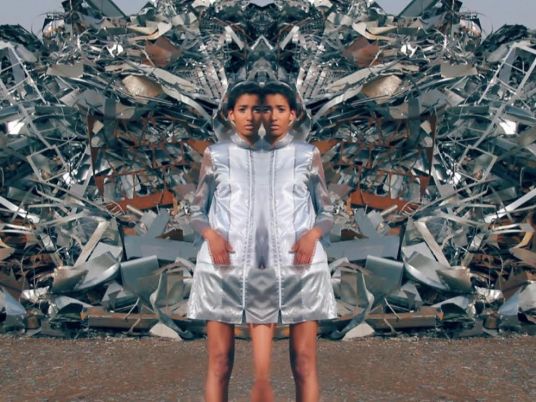Over the past 20 years, Egypt has been subjected to many ups and downs, many of which are represented at Mashraeya Gallery’s “20”: earthquakes, three consecutive African Cup titles, political outrage, and lights covering the Cairo Tower.
In the heart of Cairo, the downtown Mashrabeya Gallery is celebrating its 20th anniversary by showcasing a medley of contemporary Egyptian artwork, encompassing a range of styles, concepts and generations.
Through tiny white arches reminiscent of the city’s old architecture, you glimpse extremes of pigment, from the bold reds and blues to murky earth colors. The canvases on the walls reflect the artists’ interpretation of the world in which they live, and freeze perceptive frames of modern life.
Photographs of Cairo’s enduring landscape lead you in to the spacious showroom. Captured by Amr Fekry, the fluctuating sepia skyline reveals contours of mosques and old buildings–a panorama witnessed daily by every Egyptian eye.
Stepping inside, the men and women who crowd the streets of Cairo are transfixed on canvas, painted by diverse artists using diverse media.
Artistic and unruly, the gallery is cluttered with painting supplies, empty frames, and literature on art. As the whiff of oil and turpentine seeps into your nostrils you glimpse Mohamed Abla’s canvas, housing typical Egyptian characters you pass by day in and day out. A policemen, a man in a galabiya, young girls, a veiled woman, and a government worker are arbitrarily assembled in the art piece–an incredibly familiar sight.
Amr el-Kafrawy is also captivated by the image and character of the Egyptian. Two large paintings stand side by side; a man and a woman looking anything but pretty. “They are not beautiful; they are rough, and full of violence,” says el-Kafrawy.
These two Egyptians on the wall are painted in muddy colors, and sharp lines segment the figures’ faces and bodies randomly, creating a truly distorted image.
“I see this man and this woman everyday in Cairo,” el-Kafrawy continues. The artist believes that despite the differences between each and every one of us, a certain disposition prevails, and it is reflected in faces all around. “I find that only one person, one body, can be reflective of most people at once.”
The darkness and harshness of el-Kafrawy’s pieces is also reflective of the dreariness of contemporary Cairo, according to the artist. “The deformation of this man and woman represents my own vision of modern-day life; depressing and gloomy.”
By contrast, Ahmed Sabry’s exhibited work is colorful, representing single frames from Egyptian movies. His paintbrush captures actors posing for the camera, rather than candid and original personalities.
Sabry’s paintings illustrate the influence of the entertainment industry on the Egyptian culture. “The more the people are exposed to certain images and behaviors in the media, the more they become integrated into the community’s culture.”
Shots from movies broadcast on Melody Aflam (Melody Movies) and Moga Comedy are painted by Sabry on miniature canvases, much smaller than any current-day TV screen.
“Our culture is made up of fake scenarios and norms, appearing and constantly reappearing in our media until they are mistaken for reality.”
Ahmed el-Askalany’s sculptures are simply crafted, yet hold deep meaning. On a donkey rides a man with a large body and a proportionally tiny head. The realization of dreams was the message behind this statue, says el-Askalany.
“The man riding on the donkey is a symbol of heading towards your dreams.” However, there is a preset flaw to the actualization of such dreams. A tiny head rests atop the man’s body, signifying people’s reliance on force rather than reason.
“Nowadays, people do not use their heads, and resort to physical power instead,” says el-Askalany.
Two other sculptures are miniature depictions of two giant animals: the elephant and the hippopotamus. Lean and simple, the animals are meant to carry beauty and modesty.
El-Askalany believes that in the past 20 years, the Egyptian public has started showing significant attention to art. “As artists, we are not as popular as other aspects of the country’s culture such as football, movies and music, but still, people’s attention to art has recently increased,” he explains.
Despite it’s exquisite art collection, the contemporary Egyptian art scene cannot be confined to the contextually limited walls of Mashrabia; to be wholly appreciated, a more diverse and extensive spread of artwork would need to represent the art landscape. So, if you want a mere glance at Egypt’s recent artistic history, head down to Mashrabeya before 18 July.




